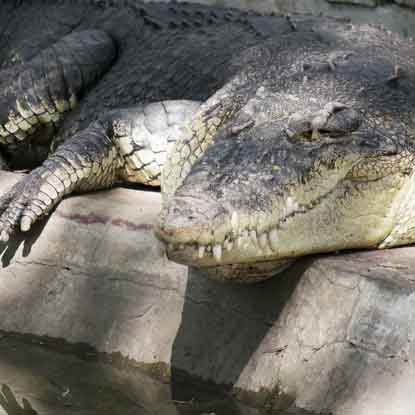In East Nusa Tenggara province, Indonesia, a woman and her son fell victims to a crocodile attacks.
While doing laundry in the Ledewero river on February 5, Alvina Doki, 64, was attacked by a large crocodile. Her husband, Gabriel Sinyo, 60, was present during the attack and tried to save her by pelting the reptile with rocks. However, the crocodile pulled her underwater and vanished.
“The victim was attacked by a crocodile while washing clothes,” stated Henry Novika Chandra, commissioner of the regional police. “Currently, her body has not been found. Our members together with the local community are still continuing the search. Hopefully the victim’s body will be found soon.”
That night, while looking for his mother’s body, Wilsilius Lomi, 35, got separated from the others and was attacked by what is believed to be the same crocodile. His body was found the next morning.
Assistant Commissioner Yusuf Tarapadjang provided details about the recovery: “We finally found Wilsilius’ body about 1,640 feet from where he was attacked. His body had a number of claw and tear wounds. The body was intact, there were only wounds on the legs and stomach from being attacked by the crocodile.”
This incident is part of a larger pattern of escalating crocodile-human conflicts in Indonesia. Over the past decade, the country has seen more than 1,000 crocodile attacks, which have resulted in 486 deaths. Since 2016, the Bangka-Belitung province alone has recorded over 60 fatalities.
In December, a 13-foot crocodile near Deaa Orahili Beach in North Sumatra took the life of Nurhawati Zihura, 46. Witnesses reported the crocodile performing a death roll before pulling her underwater. The locals tried to recover her body by throwing dead chickens into the water to distract the crocodile.
In August 2024, an incident occurred in Wali village, eastern Indonesia, where a 54-year-old woman, Halima Rahakbauw, was killed while swimming in a river. Parts of her body were recovered after the villagers killed the 13-foot crocodile.
Recently, in January, in the Bangka-Belitung Islands, a five-year-old girl named Chaca became another victim when a saltwater crocodile grabbed her while she was bathing in an abandoned tin-ore mining pond. “The victim was snatched by a crocodile,” said I Made Oka Astawa, head of the search and rescue agency in Pangkalpinang. Her body was found the following morning after a thorough search involving local rescuers, the army, and police.
In West Kalimantan province, another woman, 44, was attacked while working on a palm oil plantation. Despite her colleague’s efforts to rescue her, the crocodile pulled her into a ditch. Her body was found 90 minutes later, still held by the crocodile.
Experts suggest that the rapid growth of palm oil plantations and logging activities are key factors in the rise of human-crocodile conflicts, especially in the rainforest areas of Borneo. These activities, along with illegal tin mining operations, have significantly reduced the natural barriers between human settlements and crocodile habitats.
Particularly affected by these deadly encounters is the Bangka island region, one of the world’s most abundant tin-mining areas. Decades of tin exploitation have deforested the island, leaving behind numerous abandoned mining pits that have turned into crocodile habitats. As land deposits decrease, miners are increasingly moving to coastal areas, pushing these predators further from their traditional territories.
Environmental experts identify several reasons for the increase in attacks. The Indonesian archipelago is home to 14 species of crocodiles, and a large population of estuarine crocodiles thrive in the local climate. Overfishing has reduced their natural food sources, while coastal development and widespread tin mining have destroyed their habitats, pushing them closer to human settlements.
Conservation authorities note that habitat loss, coupled with local communities’ continued dependence on rivers for daily activities, has created hazardous conditions for human-crocodile interaction.

